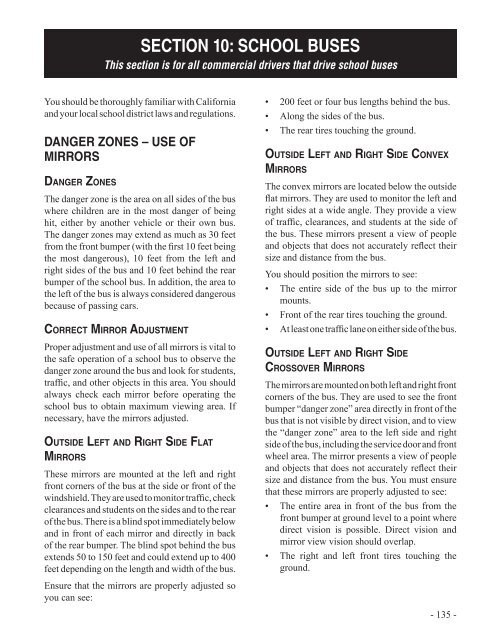Commercial Driver Handbook ( PDF ) - California Department of ...
Commercial Driver Handbook ( PDF ) - California Department of ...
Commercial Driver Handbook ( PDF ) - California Department of ...
Create successful ePaper yourself
Turn your PDF publications into a flip-book with our unique Google optimized e-Paper software.
You should be thoroughly familiar with <strong>California</strong><br />
and your local school district laws and regulations.<br />
DAngeR zOneS – uSe OF<br />
mIRRORS<br />
danger zones<br />
SectIOn 10: SchOOl BuSeS<br />
This section is for all commercial drivers that drive school buses<br />
The danger zone is the area on all sides <strong>of</strong> the bus<br />
where children are in the most danger <strong>of</strong> being<br />
hit, either by another vehicle or their own bus.<br />
The danger zones may extend as much as 30 feet<br />
from the front bumper (with the first 10 feet being<br />
the most dangerous), 10 feet from the left and<br />
right sides <strong>of</strong> the bus and 10 feet behind the rear<br />
bumper <strong>of</strong> the school bus. In addition, the area to<br />
the left <strong>of</strong> the bus is always considered dangerous<br />
because <strong>of</strong> passing cars.<br />
CorreCt mirror adjustment<br />
Proper adjustment and use <strong>of</strong> all mirrors is vital to<br />
the safe operation <strong>of</strong> a school bus to observe the<br />
danger zone around the bus and look for students,<br />
traffic, and other objects in this area. You should<br />
always check each mirror before operating the<br />
school bus to obtain maximum viewing area. If<br />
necessary, have the mirrors adjusted.<br />
outside left and right side flat<br />
mirrors<br />
These mirrors are mounted at the left and right<br />
front corners <strong>of</strong> the bus at the side or front <strong>of</strong> the<br />
windshield. They are used to monitor traffic, check<br />
clearances and students on the sides and to the rear<br />
<strong>of</strong> the bus. There is a blind spot immediately below<br />
and in front <strong>of</strong> each mirror and directly in back<br />
<strong>of</strong> the rear bumper. The blind spot behind the bus<br />
extends 50 to 150 feet and could extend up to 400<br />
feet depending on the length and width <strong>of</strong> the bus.<br />
Ensure that the mirrors are properly adjusted so<br />
you can see:<br />
• 200 feet or four bus lengths behind the bus.<br />
• Along the sides <strong>of</strong> the bus.<br />
• The rear tires touching the ground.<br />
outside left and right side Convex<br />
mirrors<br />
The convex mirrors are located below the outside<br />
flat mirrors. They are used to monitor the left and<br />
right sides at a wide angle. They provide a view<br />
<strong>of</strong> traffic, clearances, and students at the side <strong>of</strong><br />
the bus. These mirrors present a view <strong>of</strong> people<br />
and objects that does not accurately reflect their<br />
size and distance from the bus.<br />
You should position the mirrors to see:<br />
• The entire side <strong>of</strong> the bus up to the mirror<br />
mounts.<br />
• Front <strong>of</strong> the rear tires touching the ground.<br />
• At least one traffic lane on either side <strong>of</strong> the bus.<br />
outside left and right side<br />
Crossover mirrors<br />
The mirrors are mounted on both left and right front<br />
corners <strong>of</strong> the bus. They are used to see the front<br />
bumper “danger zone” area directly in front <strong>of</strong> the<br />
bus that is not visible by direct vision, and to view<br />
the “danger zone” area to the left side and right<br />
side <strong>of</strong> the bus, including the service door and front<br />
wheel area. The mirror presents a view <strong>of</strong> people<br />
and objects that does not accurately reflect their<br />
size and distance from the bus. You must ensure<br />
that these mirrors are properly adjusted to see:<br />
• The entire area in front <strong>of</strong> the bus from the<br />
front bumper at ground level to a point where<br />
direct vision is possible. Direct vision and<br />
mirror view vision should overlap.<br />
• The right and left front tires touching the<br />
ground.<br />
- 135 -

















